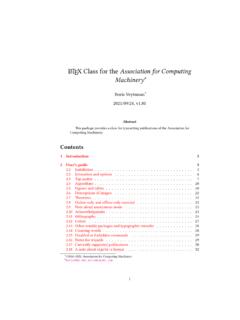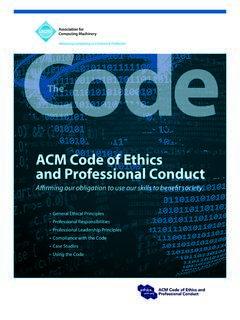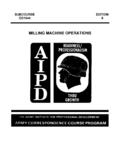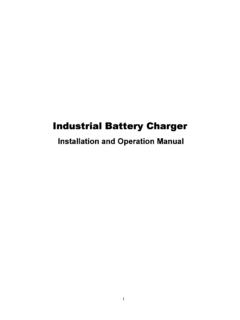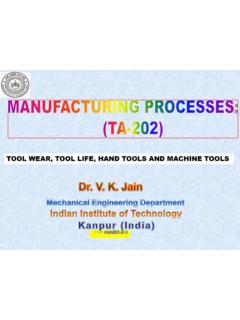Transcription of Submission Template for ACM Papers
1 Submission Template for ACM Papers This is Short Title of the paper, used in page headers This is the subtitle of the paper, this document both explains and embodies the Submission format for authors using Word First Author's Name, Initials, and Last name* First author's affiliation, an Institution with a very long name, Second Author's Name, Initials, and Last Name Second author's affiliation, possibly the same institution, Third Author's Name, Initials, and Last Name Third author's affiliation, possibly the same institution, Although there is no distinctive header, this is the abstract. This Submission Template allows authors to submit their Papers for review to an ACM Conference or Journal without any output design specifications incorporated at this point in the process. The ACM manuscript Template is a single column document that allows authors to type their content into the pre-existing set of paragraph formatting styles applied to the sample placeholder text here.
2 Throughout the document you will find further instructions on how to format your text. If your conference s review process will be double-blind: The submitted document should not include author information and should not include acknowledgments, citations or discussion of related work that would make the authorship apparent. Submissions containing author identifying information may be subject to rejection without review. Upon acceptance, the author and affiliation information must be added to your paper. CCS CONCEPTS Insert your first CCS term here Insert your second CCS term here Insert your third CCS term here Additional Keywords and Phrases: Insert comma delimited author-supplied keyword list, Keyword number 2, Keyword number 3, Keyword number 4 ACM Reference Format: First Author s Name, Initials, and Last Name, Second Author s Name, Initials, and Last Name, and Third Author s Name, Initials, and Last Name. 2018. The Title of the Paper: ACM Conference Proceedings Manuscript Submission Template : This is the subtitle of the paper, this document both explains and embodies the Submission format for authors using Word.
3 In Woodstock 18: ACM Symposium on Neural Gaze Detection, June 03 05, 2018, Woodstock, NY. ACM, New York, NY, USA, 10 pages. NOTE: This block will be automatically generated when manuscripts are processed after acceptance. * Place the footnote text for the author (if applicable) here. 2 1 INTRODUCTION ACM's new manuscript Submission Template aims to provide consistent styles for use across ACM publications, and incorporates accessibility and metadata-extraction functionality necessary for future Digital Library endeavors. Numerous ACM and SIG-specific templates have been examined, and their unique features incorporated into this single new Template . If you are new to publishing with ACM, this document is a valuable guide to the process of preparing your work for publication. If you have published with ACM before, this document provides insight and instruction into the current process for preparing` your manuscript.
4 This Submission Template allows authors to submit their Papers for review to an ACM Conference or Journal without any output design specifications incorporated at this point in the process. The ACM Submission Template is a single column MS-Word document that allows authors to type their content into the pre-existing set of paragraph formatting styles applied to the sample placeholder text here, or copy-and-paste their text and then apply the respective paragraph styles (Windows: you can open the Styles task pane from the Home tab [it can also be opened with the keyboard shortcut Alt+Ctrl+Shift+S]; MAC16: you can access the Styles pane at the right of the Home toolbar.) Highlight a section that you want to designate with a certain style, and then select the appropriate style from the list. To view which style is being used in any part of this document, place your cursor on your text and look at the Current style field in the Styles pane. It is beneficial to create your document in draft mode with the style panel open in the left-side panel.
5 If the panel is not immediately visible when the Submission Template is opened, you will need to open the panel manually for Windows: click on the following from the main ribbon above: File > Options > Advanced > Display > Style area pane width in Draft and Outline views. Set the style area width (1 " is a good starting value.); for MAC: go to the View menu and select Draft ; then go to the Word menu and select Preferences and then View, under the Window section insert inches under the style area width. All style elements are specified in this Template to facilitate the production of your paper and to have the styles consistent throughout. The paragraph styles are built-in and examples of the styles are provided throughout this document. Save as you go and backup your work regularly! Accessibility Following the guidelines throughout this Template will also improve the accessibility of your manuscript and increase the audience for your work. Ensure that heading styles are applied as instructed, tables are created using Word s table feature (rather than an image), figures have a text equivalent, and list styles are applied as instructed.
6 To increase the accessibility of your manuscript, you should set the title and language metadata. On Word for Windows, open the File tab and click on Info. On Word for Mac, click the File Menu and select Properties, then click the Summary tab. Fill in the title of your document. For anonymous review, clear the author field. To set the document language, click the Review tab in the Ribbon. On Word for Windows: Click the Language button and select Set Proofing Language. Verify the language is set correctly. On Word for Mac: Click the Language button and select the document language from the pop-up. More about the Submission Template This Submission version of your paper should not have headers or footers, these will be added when your manuscript is processed after acceptance. It should remain in a one-column format please do not alter any of the styles or margins. If a paper is accepted for publication, authors will be instructed on the next steps. Authors must then follow the Submission instructions found on their respective publication s web page.
7 Once your Submission is received, your paper 3 will be processed to produce the formatted Word, PDF, and HTML5 output formats, which will be provided to you for review, revision/resubmission (if applicable), and approval. Inserting CCS concepts The new Template enables you to import required indexing concepts for your article from the ACM Computing Classification System (CCS) using an indexing support tool found in the ACM Digital Library (DL). The tool generates formatted text after you have selected your terms. To insert CCS terms into your document, copy and paste the formatted text from the CCS tool using the link into the CCS CONCEPTS section. An additional step is necessary to ensure that the proper CCS terms are added to the Digital Library citation page: from the view CCS TeX Code listing, click on Show the XML Only. Highlight and copy the XML code from the window. You must insert the XML code into your Word document s properties: from your Word document, click on File , then click on the Info tab on the left-hand side panel, then click Properties and select Show All Properties.
8 Click within the Comments metadata field and paste the XML data. 2 INSERTING CONTENT ELEMENTS The next subsections provide instructions on how to insert figures, tables, and equations in your document. Tables Tables are float elements which should be inserted after their first text reference and have specific styles for identification. Do not use images to present tables, or they will be inaccessible to readers using assistive technologies. Authors can insert tables by using the MS Word option (INSERT ->Table) and providing the required row and column size. Every table must have a caption (title) above it, which must have the TableCaption style applied. Please note that tables should not be supplied as image files, but if they are images they must have the Image style applied. As an example, Table 1 shows all the styles available in this Template , to be applied to the respective element of your text. Table 1: Styles available in the Word Template Style Tag Definition Style Tag Definition Title_document main title of article ListParagraph list items Subtitle subtitle of article Statements math statements Authors author name Extract block quotations Affiliation author affiliation information Algorithm Caption caption for algorithm AuthNotes footnote to author(s)
9 AckHead heading for acknowledgements Abstract abstract text AckPara acknowledgements text CCSHead heading for CSS Concepts GrantSponsor sponsor of grant CCSD escription CSS terms GrantNumber number for the grant KeyWordHead heading for keywords ReferenceHead heading for references Keywords keywords text Bib_entry references ORCID author's ORCHID # AppendixH1 appendix heading level 1 Head1 heading level 1 AppendixH2 appendix heading level 2 Head2 heading level 2 AppendixH3 appendix heading level 3 Head3 heading level 3 TableCaption title of table PostHeadPara first paragraph after a heading TableHead TableFootnote column head of table footnote to table Para Subsequent paragraphs of general text Image figures 4 Style Tag Definition Style Tag Definition ParaContinue DisplayFormula flush left text after display items like math equations, lists etc. numbered math equation DOI Digital object identifier DisplayFormulaUnnum unnumbered equations Label labela ComputerCode Display Computer codes In-text code intext computer code Short Title Short title of article History Dates of article a This is example of table footnote.
10 Tables can be very difficult for people using screen reader technology to understand unless they include markup that explicitly defines the relationships between all the parts ( : headers and data cells). A key to making data tables accessible to screen reader users is to clearly identify column and row headers. In Word, authors should identify which row or rows contain column headers. Below are the steps to do this: 1. Select that table s row, then right-click the row and select Table Properties ; 2. In the Table Properties window, click the Row tab and select the box that says Repeat as header row at the top of each page. Or Apply the table head style by highlighting the respective row and applying the TableHead style found in the Body Element section of the ACM Master Article Template . Figures Figures are float elements which should be inserted after their first text reference, and have specific styles for identification. Insert a figure and apply the Image paragraph style to it.
